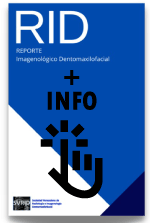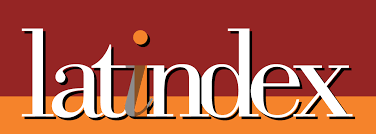Information For Authors
REPORTE IMAGENOLÓGICO DENTOMAXILOFACIAL
GUIDE FOR AUTHORS
Updated on November 7, 2023.
GENERAL CONSIDERATIONS
Reporte Imagenológico Dentomaxilofacial is an electronic publication in Spanish, English and Portuguese aimed at reporting cases and case series of Dentomaxillofacial Radiology and Imaging, open access and double-blind peer review by a body of specialized reviewers. Likewise, technical reports, short communications and pictorial reviews are accepted.
Manuscripts must comply with the latest version of the recommendations of the International Committee of Medical Journal Editors (http://www.icmje.org) and meet all specifications described in these GUIDELINES FOR AUTHORS. Authors must strictly adhere to these guidelines to facilitate the editorial process. The journal does not charge authors for submission, reviewing or processing of manuscripts.
All works must be original and unpublished and must not have been published or be refereed by other journals. If the work was presented at a conference or similar, the corresponding details (full name of the conference, date, place, organizing institution) must be provided as a note on the “Manuscript Title Page”.
Manuscripts must be submitted in Word file format, letter-size page (215.9 x 279.4 mm), Arial 12 font, with 2.5 cm margins on all sides. The body of the text must be double spaced and justified. Pages numbered in the upper right margin. Only the title in Spanish and the title in English will be written in capital letters and bold, the section headings in capital letters.
TITLE PAGE
Manuscripts must include a first
page or “Title Page”, which must be sent as a separate file from the manuscript, with the following information:
Title in Spanish, followed by its translation into English, with a maximum length of 20 words.
Name of the authors (one is allowed maximum of five authors, with the exception of the editorial, where the maximum is three). Each author has to indicate the highest academic degree , institutional affiliation, email and ORCID (orcid.org). Indicate with an asterisk after the last name, the authorfor correspondence. Provide the address full version of the corresponding author and email, this information is placed before references.
Example:
Corresponding author: Miranda Oberto. Av. 19 with Calle 65. Faculty of Dentistry, University of Zulia. Maracaibo, Venezuela (mirandaoberto@gmail.com)
The body of the manuscript begins with a page indicating the title of the work in Spanish and its translation into English. This page must be numbered.
ABSTRACT AND KEYWORDS
The abstract will have a maximum of 250 words. It will be presented in Spanish and English. At the end of the summary, between three to five “keywords” separated by a comma should be included; Its selection in Spanish is made by consulting the Descriptors in Health Sciences (DeCS) (http://decs.bvs.br). Key words in English should be consulted in the Medical Subject Headings (MeSH) (http://www.nlm.nih.gov/mesh/MBrowser.html)
ABBREVIATIONS
Avoid using abbreviations in the title or abstract. The first time you introduce the abbreviation, place its acronym in parentheses, in capital letters, immediately after the term or expression it explains, then use the abbreviation throughout the body of the manuscript.
REFERENCES
The format of references must follow the guidelines of the International Committee of Editors of Medical Journals (Vancouver Standards). References must be cited in the text, according to the order of appearance of the author, using Arabic numerals placed in supra-index after the punctuation mark. When the quote has more than one reference, the numbers must be separated by a comma (Example: 3,5,7); If the quotes are consecutive, the first and last quotes must be placed, separated by a hyphen. (Example: 4-6). Personal communications and unpublished data should not be cited as a reference. In the reference of an article all authors must be listed if there are six; if there are seven or more, place the first six followed by “et al.” in italic. The most common examples of bibliographic references are presented below:
1. Scientific journal article with up to six authors:
Walewski LÂ, Tolentino ES, Yamashita FC, Iwaki LCV, da Silva MC. Cone beam computed tomography study of osteoarthritic alterations in the osseous components of temporomandibular joints in asymptomatic patients according to skeletal pattern, gender, and age. Oral Surg Oral Med Oral Pathol Oral Radiol. 2019;128(1):70-7. DOI: https://doi.org/10.1016/j.oooo.2019.01.072
2. Scientific journal article with more than six authors:
Kato CNAO, Barra SG, Amaral TMP, Silva TA, Abreu LG, Brasileiro CB, et al. Cone-beam computed tomography analysis of cement-osseous dysplasia-induced changes in adjacent structures in a Brazilian population. Clin Oral Investigative. 2020;24(8):2899-908. DOI: https://doi.org/10.1007/s00784-019-03154-x
3. Article in online journal:
Ravelo J, Ortiz Y, Drumond E, Villarroel-Dorrego M. Recurrent mandibular ameloblastic fibroma. Clinical case presentation. [Internet]. 2021 [cited June 15, 2021];59(1). Available at: https://www.actaodontologica. com/editions/2021/1/art-2/
4. Books and monographs:
Isberg A. Dysfunction of the temporomandibular joint. A practical guide for the professional. 2nd ed. São Paulo: Latin American Medical Arts; 2015.
5. Chapter or part of a book:
Hernández A. Virtual sinuscopy. In: Freitas A, Rosa JE, Souza IC. Dental Radiology. 6th ed. São Paulo: Medical Arts: 2004. p. 771-777.
6. Theses and/or scientific dissertations:
Ballarta F. Position and diameter of the posterior superior alveolar artery and its relationship with the presence of posterior superior teeth in tomography scans of adult patients [bachelor's thesis]. [Lima]: Faculty of Dentistry, Universidad Nacional Mayor de San Marcos; 2021. 92 p.
7. Web pages, blogs or online queries:
World Health Organization. Protocol for evaluating possible risk factors for coronavirus disease 2019 (COVID-19) for health workers in healthcare environments. [Consulted on February 24, 2021]. Accessible at: https://apps.who.int/iris/bitstream/handle/10665/332344/WHO-2019-nCoV-HCW_risk_factors_protocol-2020.3-spa.pdf
FIGURES' PREPARATION
The figures must be cited within the text in the corresponding place, numbered in Arabic, accompanied by a descriptive legend at the bottom:
- A maximum of six (06) figures are allowed, except for Pictorial Reviews, where a maximum of 15 are accepted.
- Arrows or other symbols may be used in the figures as few as possible and only if you wish to highlight a feature of interest, as long as this does not make the finding difficult to observe.
- Delete the guidance guides generated by the visualization software, if it is an imaging study method, unless they are required for the explanation of an analysis protocol.
- Collage (Composite) figures are preferred when they represent the evaluation sequence of an anatomical structure, anomaly or injury; Place a capital letter in the upper left margin, starting with the letter “A” (Font “Arial” in capital letters), in the first image, the other letters follow clockwise.
- Images must be sent in separate files, not included in the manuscript, in PNG or JPG format, with a minimum resolution of 300 dpi. Color figures are accepted.
- Guarantee the anonymity of the patient in all figures sent, do not include their name or any other information that may contribute to their identification.
- Figure legends should be included at the end of the tables, on a separate sheet.
TABLES' PREPARATION
The tables must be cited within the text in the corresponding place, numbered in Arabic. Each table must be accompanied with a descriptive title at the top:
- Tables should be self-explanatory and not duplicate data in the text or figures.
- Include horizontal lines at the top and bottom of the table and below the columns that indicate the variables studied. Do not include vertical lines.
- Tables must be presented double spaced.
- You can include notes at the foot of the table indicating the statistical tests used and defining the abbreviations used. Each footnote must start on a new line.
- Tables should be placed at the end of the manuscript, after references, on separate pages and be editable, not images.
KNOWLEDGEMENT
This section is optional, it is used to recognize the contribution of people or institutions in the research, but they cannot be considered co-authors. It must be located before the declaration of conflicts of interest.
INTEREST CONFLICT
Authors must include a declaration of conflict of interest. This section is placed before the references and after the acknowledgments if any.
Example:
Conflicts of interest: The authors declare that they have no conflicts of interest.
MEASUREMENT UNITS
Measurements of length, height, weight and volume will be expressed in units of the Decimal Metric System (meter, kilogram, liter, etc.) or their multiples and submultiples. Temperatures will be recorded in degrees Celsius. Blood pressure values will be indicated in millimeters of mercury (mm Hg). All blood and clinical chemistry values will be presented in units of the decimal metric system and in accordance with the International System of Units. The preferred dental nomenclature is that adopted by the International Dental Federation, the two digits can be separated by a period (Example: 2.1) or not (21). The use of another dental nomenclature system must be indicated in the text.
TYPES OF ARTICLES
CASE REPORT
It is the presentation of a case or series of cases, with emphasis on the imaging aspect of an anatomical variant, anomaly or pathology present in the dentomaxillofacial complex. The total number of words in the manuscript should not exceed 1800, including figure legends and references. Case reports must include the following sections: Introduction, Presentation of the case, Discussion and Bibliographic References.
It is recommended to follow the CARE guidelines (https://www.care-statement.org/checklist), in order to increase the accuracy, transparency and usefulness of case reports and case series.
Abstract and keywords
The summary must be written in a continuous, unstructured manner, including a brief definition of the entity to be reported and the presentation of the case.
Introduction
Briefly and clearly include the most current information about the entity to be reported in the case, highlighting aspects related to prevalence, sex predilection, clinical and imaging presentation, and its clinical importance.
Case Presentation
This section should include all relevant information about the case, with emphasis on obtaining and processing radiological images. The case description should include patient demographics, reason for consultation, and current illness. The result of the imaging studies must be adequately illustrated with the respective figures, providing a presumptive diagnosis or a definitive one if the histopathological examination is available.
Discussion
Support your findings, establishing similarities or differences with similar cases. You should emphasize the differential diagnosis and, if pertinent, present two possible diagnoses, explaining the rationale in selecting the final diagnosis.
References
Include a maximum of fifteen (15) updated bibliographic references (last five years). It may include older references if it is bibliography that refers to the first time the entity reported in the case was described, some method or classification of relevance to the work.
TECHNICAL REPORTS
The technical report describes a technique, image analysis procedure or software of interest to the clinician and researcher. The report has a maximum of 4000 words and presents the following structure: Introduction, Materials and methods, Results, Discussion and References.
Abstract and keywords
The summary must be written in a continuous, structured manner, presenting the following sections: Objective, Methods, Results and Conclusions.
Introduction
Briefly describe the variables studied, the practical relevance of the study and its purpose.
Materials and methods
Include all relevant information that enables the reproducibility of the reported techniques and procedures.
Results
Present succinctly, the proposed technique or procedure, with the support of figures.
Discussion
Indicate the applicability of the techniques and procedures developed and the limitations of the study. Contrast your findings with those of other authors if possible.
References
Include a maximum of fifteen (15) updated bibliographic references. last five years). It may include older references if it is bibliography that refers to the first time the entity reported in the case was described, some method or classification of relevance to the work.
SHORT COMMUNICATIONS
Short communications represent articles that describe original work in its initial phase and do not represent the entire research. This type of article contains between 1000 and 2000 words with 5-15 references, following the structure of an original work: Introduction, Materials and methods, Results, Discussion, Conclusions and References.
The abstrasct must be written continuously, structured, presenting the following sections: Objective, Methods, Results and Conclusions.
Introduction
Briefly describe the variables studied, the practical relevance of the study and its purpose.
Materials and methods
Include all relevant information that enables the reproducibility of the reported techniques and procedures.
Results
Present succinctly the results obtained that respond to the stated objective, with the support of tables and/or figures.
Discussion
Discuss the results found within the framework of their possible explanations and contrast your findings with those of other authors. Indicate the clinical relevance of the study, its limitations and possible research derived from it.
References
Include a maximum of fifteen (15) updated bibliographic references. last five years). It may include older references if it is bibliography that refers to the first time the entity reported in the case was described, some method or classification of relevance to the work.
PICTORIAL REVIEWS
Pictorial reviews constitute a type of narrative review where the figures have special relevance, contain between 1000-3000 words and require the following structure: Introduction, Subtitles that organize the relevant information, Discussion (Optional), Conclusions and References.
Summary and keywords
The summary must be written in a continuous, unstructured manner, presenting the topic to be discussed in the review and its purpose.
Introduction
The introduction should be brief, no more than two paragraphs, briefly describing the topic developed and concluding with the purpose/objective of the work.
Subsections
Organize the information in the subsections that you consider necessary and must be supported with sufficient and necessary figures.
References
Include a minimum of 20 updated bibliographic references.
CHECKLIST FOR
SUBMISSION PREPARATION
- The work has not been previously published, nor has it been submitted to another journal.
- The manusccript is in a file
Microsoft Word. - The manuscript has the maximum number of words required according to the type of work.
- The text is double-spaced, in ARIAL 12 font, including tables, figure legends, references, etc.
- Title page. Separated from the body of the manuscript and sent as a separate file, containing the titles in Spanish or Portuguese and their equivalent in English; the authors, with their highest academic degree, affiliation, institutional email and ORCID.
- The body of the manuscript begins with a page indicating the title of the work in Spanish or Portuguese and its translation into English. This page must be numbered.
- ABSTRACT in Spanish, English or Portuguese according to the type of job.
- Manuscript text organized in
sections according to the type of work. - Keywords in Spanish or Portuguese based on the DeCS (http://
decs.bvs.br) and key words in English from MeSH (http://nlm.
nih.gov/mesch/MBrowser.html) - Conflict of Interest is evident.
- References are found
in the Vancouver style.
For additional information and submission of the manuscript, write to the email: reporte.imagenologicovzla@gmail.com
Dr. Ana Isabel Ortega-Villalobos.
Editor in Chief
Reporte Imagenológico Dentomaxilofacial. Sociedad Venezolana de Radiología e Imagenología Dentomaxilofacial.
Are you interested in publishing in the Journal? It is recommended that you review the About the Journal page to consult the journal's section policies, as well as the Author Guidelines. Authors must register with the journal before publishing or, if already registered, they can simply log in and begin the five-step process.










